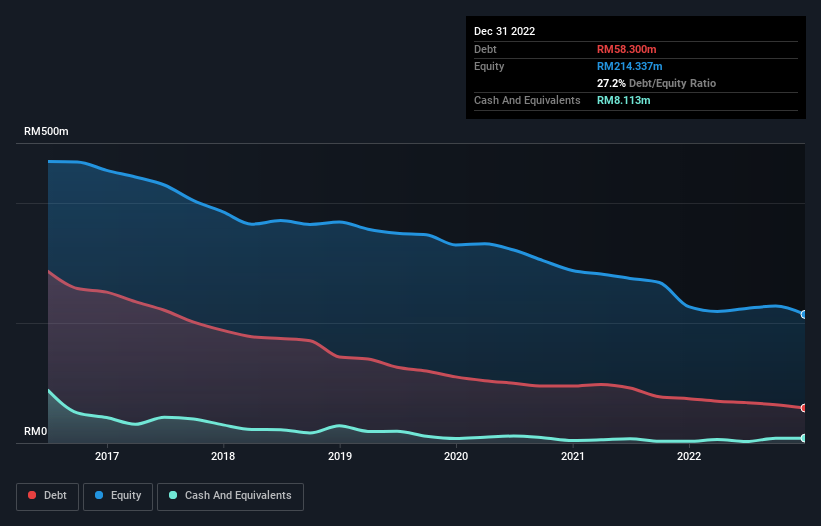Is Sealink International Berhad (KLSE:SEALINK) Using Debt Sensibly?

Some say volatility, rather than debt, is the best way to think about risk as an investor, but Warren Buffett famously said that 'Volatility is far from synonymous with risk.' So it might be obvious that you need to consider debt, when you think about how risky any given stock is, because too much debt can sink a company. As with many other companies Sealink International Berhad (KLSE:SEALINK) makes use of debt. But the real question is whether this debt is making the company risky.
When Is Debt Dangerous?
Debt is a tool to help businesses grow, but if a business is incapable of paying off its lenders, then it exists at their mercy. In the worst case scenario, a company can go bankrupt if it cannot pay its creditors. However, a more common (but still painful) scenario is that it has to raise new equity capital at a low price, thus permanently diluting shareholders. Of course, debt can be an important tool in businesses, particularly capital heavy businesses. The first thing to do when considering how much debt a business uses is to look at its cash and debt together.
View our latest analysis for Sealink International Berhad
What Is Sealink International Berhad's Net Debt?
As you can see below, Sealink International Berhad had RM58.3m of debt at December 2022, down from RM73.8m a year prior. However, because it has a cash reserve of RM8.11m, its net debt is less, at about RM50.2m.

A Look At Sealink International Berhad's Liabilities
We can see from the most recent balance sheet that Sealink International Berhad had liabilities of RM81.9m falling due within a year, and liabilities of RM33.7m due beyond that. Offsetting this, it had RM8.11m in cash and RM19.1m in receivables that were due within 12 months. So its liabilities total RM88.4m more than the combination of its cash and short-term receivables.
The deficiency here weighs heavily on the RM45.0m company itself, as if a child were struggling under the weight of an enormous back-pack full of books, his sports gear, and a trumpet. So we'd watch its balance sheet closely, without a doubt. After all, Sealink International Berhad would likely require a major re-capitalisation if it had to pay its creditors today. When analysing debt levels, the balance sheet is the obvious place to start. But you can't view debt in total isolation; since Sealink International Berhad will need earnings to service that debt. So if you're keen to discover more about its earnings, it might be worth checking out this graph of its long term earnings trend.
In the last year Sealink International Berhad wasn't profitable at an EBIT level, but managed to grow its revenue by 72%, to RM65m. With any luck the company will be able to grow its way to profitability.
Caveat Emptor
While we can certainly appreciate Sealink International Berhad's revenue growth, its earnings before interest and tax (EBIT) loss is not ideal. Its EBIT loss was a whopping RM18m. Considering that alongside the liabilities mentioned above make us nervous about the company. We'd want to see some strong near-term improvements before getting too interested in the stock. For example, we would not want to see a repeat of last year's loss of RM20m. And until that time we think this is a risky stock. There's no doubt that we learn most about debt from the balance sheet. But ultimately, every company can contain risks that exist outside of the balance sheet. For example Sealink International Berhad has 3 warning signs (and 2 which make us uncomfortable) we think you should know about.
When all is said and done, sometimes its easier to focus on companies that don't even need debt. Readers can access a list of growth stocks with zero net debt 100% free, right now.
New: Manage All Your Stock Portfolios in One Place
We've created the ultimate portfolio companion for stock investors, and it's free.
• Connect an unlimited number of Portfolios and see your total in one currency
• Be alerted to new Warning Signs or Risks via email or mobile
• Track the Fair Value of your stocks
Have feedback on this article? Concerned about the content? Get in touch with us directly. Alternatively, email editorial-team (at) simplywallst.com.
This article by Simply Wall St is general in nature. We provide commentary based on historical data and analyst forecasts only using an unbiased methodology and our articles are not intended to be financial advice. It does not constitute a recommendation to buy or sell any stock, and does not take account of your objectives, or your financial situation. We aim to bring you long-term focused analysis driven by fundamental data. Note that our analysis may not factor in the latest price-sensitive company announcements or qualitative material. Simply Wall St has no position in any stocks mentioned.
About KLSE:SEALINK
Sealink International Berhad
An investment holding company, owns, builds, and operates a fleet of offshore marine support vessels in Malaysia, Singapore, and Vietnam.
Flawless balance sheet and good value.
Market Insights
Community Narratives



